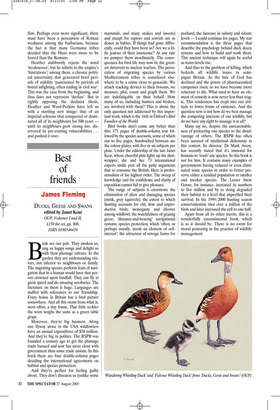Best of friends
James Fleming
DUCKS, GEESE AND SWANS edited by Janet Kear OUP, Volumes I and II, £150 the set, pp. 908, ISBN 0198546459 Birds are our pals. They awaken us, sing us happy songs and delight us with their plumage colours. In the garden they are undemanding visitors, not inferior to neighbours or family. The migrating species perform feats of navigation that in a human would have that person crowned upon landfall. They can fly at great speed and do amazing acrobatics. The literature on them is huge. Languages are stuffed with references to our friendship. Every house in Britain has a bird picture somewhere. And all this stems from what is, most often, a tiny frame. That little scolder the wren weighs the same as a green table grape.
Moreover, they’re big business. Along one flyway alone in the USA wildfowlers have an annual expenditure of $58 million. And they’re big in politics. The RSPB was founded a century ago to get the plumage trade banned and now has more clout with government than some trade unions. In this book there are four double-column pages detailing the international agreements on habitat and species protection.
And they’re perfect for feeling guilty about. They don’t threaten us (unlike some mammals, and many snakes and insects) and except for raptors and corvids are as douce as babies. If things had gone differently, could they have been us? Are we a little jealous of their innocence? At any rate we pamper them inordinately. The consequences for bird life may now be the greatest deterrent to nuclear warfare. The persecution of migrating species by various Mediterranean tribes is considered elsewhere to be a crime close to genocide. We attach tracking devices to their bosoms, we measure, plot, count and graph them. We are indefatigable on their behalf. How many of us, including hunters and birders, are involved with them? This is about the only question not addressed by this important work, which is the 16th in Oxford’s Bird Families of the World.
Bird books don’t come any better than this: 171 pages of double-column text followed by the species accounts, some of which run to five pages. Sandwiched between are the colour plates, with five or six subjects per plate. Under the editorship of the late Janet Kear, whose cheerful phiz lights up the dustwrapper, she and her 73 international experts stride past all the petty arguments that so consume the British. Here is professionalism of the highest order. The sweep of knowledge and the confidence and clarity of exposition cannot fail to give pleasure.
The range of subjects is enormous: the elimination of alien and damaging species (mink, grey squirrels); the extent to which hunting accounts for old, slow and unproductive birds; monogamy and divorce among wildfowl; the watchfulness of grazing geese; ‘distance-and-bearing’ navigational systems; species protection, which ‘often, or perhaps usually, needs an element of selfinterest’; the attraction of sewage farms for pochard; the increase in salinity and nitrate levels — I could continue for pages. My star recommendation is the three pages that describe the psychology behind duck decoy systems and how to build and work them. This ancient technique will again be useful as water-levels rise.
And thus to the problem of killing, which bedevils all wildlife issues in semipagan Britain. As the lure of God has declined and the power of pharmaceutical companies risen, so we have become more reluctant to die. What used to have an element of comedy is now never less than tragic. This tenderness has crept into our attitude to lower forms of existence. And the question now is not how do we best manage the competing interests of our wildlife, but do we have any right to manage it at all?
Many say no, despite the unreasonableness of protecting one species to the disadvantage of others. The RSPB has often been accused of intellectual dishonesty in this context. Its director, Dr Mark Avery, has recently stated that it’s immoral for humans to ‘trash’ any species. So this book is not for him. It contains many examples of governments having reduced or even eliminated some species in order to better preserve either a residual population or smaller and meeker species. The Lesser Snow Goose, for instance, increased its numbers to five million and by so doing degraded their habitat to a level that imperilled their survival. In the 1999/2000 hunting season conservationists shot over a million of the birds and later increased the cull to one half.
Apart from all its other merits, this is a wonderfully unsentimental book, which is as it should be. There is no room for moral posturing in the practice of wildlife management.











































 Previous page
Previous page